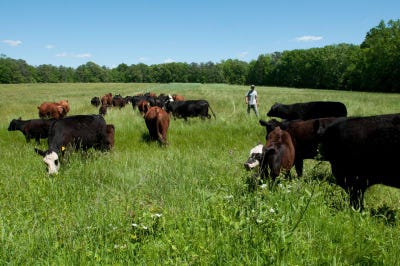April 20, 2015

Although many ranchers are facing dry conditions right now, for those fortunate producers who have received ample rain this spring, there is the potential for grass tetany when cattle graze on lush spring grasses. It is caused by a magnesium deficiency in mature cattle grazing on lush spring grasses. Here are 4 things ranchers need to know about grass tetany:
1. Recognize the symptoms
Be aware of the symptoms of grass tetany, which can quickly result in death if ignored. According to a recent article on grass tetany on Ag Answers, Tracy Turner advises, “Look for muscles twitching in the flank, lack of muscle coordination, cows grazing away from the rest of the herd, irritability, wide eyes and staring, staggering, collapse, thrashing and coma.”

Photo Credit: USDA
“Now is the time to start thinking about grass tetany and taking steps to prevent it from happening,” says Rory Lewandowski, Ohio State University Extension agriculture and natural resources educator. “Producers who are grazing cattle in areas with cover crops need to also be aware that certain cover crops such as winter wheat and winter rye are considered higher-risk forages with regard to grass tetany. Grass tetany can come on very quickly, so we just want to remind producers to be aware that it is a potential problem so they won’t run into a worst-case situation and lose an animal.”
3. Prevention is key
Lewandowski recommends offering cattle a high-magnesium mineral mix one or two weeks before spring grazing begins and throughout the spring grazing period. He says a free-choice mix should contain 12%-15% magnesium from magnesium oxide. Mix with something like molasses to encourage cattle to eat it and offer approximately 4-ounce portions per cow through spring.
READ: Salt can prevent and treat grass tetany
For another school of thought on prevention, read “Specialists refute grass tetany/salt article.”
4. Treatment options
Heather Smith Thomas writes that offering legume hay with higher levels of calcium and magnesium, as well as supplemental magnesium, are two tactics for prevention and treatment of tetany. For severe cases, administer an intravenous (IV) dose of 200-500 ml of calcium borogluconate solution containing 5% magnesium hypo phosphate or inject 200-300 ml of magnesium sulfate solution (Epsom salts) under the skin. For more details on treatment options, read “Protect against tetany.”
Have you ever had to worry about grass tetany? How do you prevent grass tetany in your cattle? Share your thoughts in the comments section below.
The opinions of Amanda Radke are not necessarily those of beefmagazine.com or Penton Agriculture.
You might also enjoy:
When should you call the vet on a difficult calving?
60+ stunning photos that showcase ranch work ethics
Try one of these 9 ranch management concepts to improve your ranch
You May Also Like



